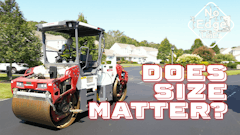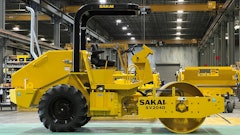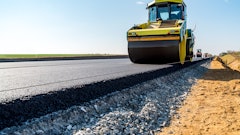
For several years now, the compact equipment market has seen strong and consistent growth. Starting with the economic downturn a decade ago, larger premium equipment purchases dropped significantly as contractors and owners tightened up budgets. The rental market saw a surge of interest for that same reason as contractors realized that high-cost, premium, specialized equipment was not earning its keep sitting idle on a jobsite for several days or weeks at a time.
If one good thing came out of the Great Recession, it was a smart and realistic reevaluation of equipment purchases vs. rentals, and a more long-term view for new job bids. “As we continue to come out of the downturn, customers are looking to take on a more diverse range of job opportunities, as well as looking at how they can reduce the cost of a job while gaining flexibility with a finite set of equipment. Compact equipment’s versatility, flexibility and transportability provide that opportunity,” says Graham Hinch, division manager, John Deere Commercial Worksite Products.
Hinch says they are seeing the traditional customer who would normally buy machines such as a dozer or backhoe take a closer look at compact track loaders and compact excavators to see if they could get the same work done using these machines with a few attachments vs. buying more task-specific equipment. “No matter which manufacturer you look at, compact equipment is more productive than it has ever been, more flexible and more versatile, which is attracting a lot of new customers to that space,” he states.
The compact equipment market addresses a common focus for equipment purchasers and users, which is return on investment over the product’s lifetime. Rental company owners as well as owner/operators are paying more attention than ever to the overall versatility of each piece of equipment, the productivity gains it can provide and total post-purchase costs.
Insights on Individual Equipment Types
 Compact equipment can enable contractors to take on a wider range of jobs using a finite set of versatile, flexible and easily transportable machines.
Compact equipment can enable contractors to take on a wider range of jobs using a finite set of versatile, flexible and easily transportable machines.
“Our focus is on track loaders, which has been a dominant and growing market that has been replacing wheeled skid steers for many applications for the past 10 years,” says Buck Storlie, testing and reliability leader, ASV Holdings, Inc. In 2017, the company saw its CTL segment surpass skid steers in market share in both the U.S. and Australia. It sees other regions around the world trending in the same direction, although at a slower rate.
The CTL is seen to have a broader array of applications and conditions within which it can work. “From a productivity standpoint, in terms of flotation, stability, pushing power and the flexibility with the rubber tracks, a CTL can work on more types of terrain and take on more jobs than a traditional wheeled skid steer can,” says Hinch. “With the CTL’s flexibility, we’re seeing our customers able to pursue and bid on more and different types of jobs than they could before.”
 Compact telehandlers are popular for applications requiring a small footprint and lower machine height.
Compact telehandlers are popular for applications requiring a small footprint and lower machine height.
Another segment of the compact equipment market experiencing strong demand is the compact telehandler. It continues to be popular for applications where a small footprint and lower machine height would be preferred or required over a traditional telehandler model, such as parking garage construction.
The applications for these machines vary greatly depending on the stage of construction. They may range from the initial phases of a large construction project where the machines can be found unloading trucks and delivering materials, to the closing stages where they can be utilized for parking garage construction and landscaping. Such versatility is really what propels this segment of the telehandler market, say John Boehme, senior product manager of telehandlers, and Rogério dos Santos, director of the telehandler platform at JLG Industries, Inc.
Much like CTLs and compact excavators, compact telehandlers are seeing increased interest due to their versatility through a growing number of attachment options. The ever-expanding attachment offerings allow each user to perform several different tasks with a single machine.
Productivity with Less Power
A huge driver of compact equipment growth has been the development of more productive, efficient and compact engine systems. Over the course of the past decade, government regulations have pressed engine manufacturers to reduce emissions, while customers have insisted it not impact overall performance.
“With the efficiency of lower horsepower engines, customers are able to consider that while a machine may not be able to dig as deep or large of an area as a larger piece of equipment, and it may take them a bit longer to complete the task, they can also now bid on five other jobs they couldn’t compete for with larger traditional pieces of construction equipment,” says Hinch. “And by investing in a few attachments, their equipment portfolio has grown in capability but not overall units — and their portfolio of business opportunities has grown. Our customers are gravitating toward that flexibility.”
 The compact track loader is seen as having a broader array of applications and conditions in which it can work compared to its wheeled counterpart. This has helped spark substantial market growth.
The compact track loader is seen as having a broader array of applications and conditions in which it can work compared to its wheeled counterpart. This has helped spark substantial market growth.
Storlie notes that the 74-hp or less machine class is also becoming more popular to leverage less stringent emissions requirements. “That particular class of equipment is being pushed to get more performance out of 74 hp,” he comments. “At ASV, we achieve that by minimizing losses on other systems, like the drive system and hydraulics. Anything you can do to get the power off of the engine and put directly toward the ground or the attachment to do work is a huge benefit for the customer.”
The construction industry overall is trending away from traditional control methods toward electrohydraulic controls, particularly in larger equipment. In turn, this is trickling down to control expectations for compact equipment operation. Leveraging more precise electrohydraulic controls allows manufacturers to optimize and customize the performance and features of the system to each unique operator or application.
“Along with the Tier 4 engines came engine control units (ECUs) and more onboard electronics,” says Storlie. “Once you introduce that onto the machine, the options just continue to progress. With electronic control adoption, we’re seeing a higher demand for the ability to adjust the machine to specific applications, attachments and operators, particularly on our higher-end machines.”
“Electrohydraulics allow an operator to get into the vehicle cab and configure the machine to his or her own skill level for the task at hand,” Hinch points out. For example, the onboard controls can be programmed specific to the boom load height. “With a single push of a button, the operator can deliver the load to the truck accurately every time and not have to manually manipulate the load each time to complete the same task over and over.
“This technology exists and is already being used by larger and more costly equipment,” he continues, “but it’s definitely something compact equipment operators are looking for now.”
Improved versatility and productivity mean a machine is able to perform more tasks and work for longer hours, which equates to operators spending more time in the cab. As a result, increased focus and attention is being placed on operator comfort and overall work environment for future equipment designs. This includes evaluating features such as more efficient HVAC systems, more comfortable seats, rear view camera systems, cab pressurization and added creature comforts such as Bluetooth radio.
Advanced Technology Considerations
Larger earthmovers such as motor graders and excavators gain productivity and efficiency improvements with onboard precision systems like grade control. Telematics is another example of a higher cost technology often seen onboard larger, more expensive equipment.
Telematics systems allow customers with high asset investment to monitor their machines’ performance, fleets and multiple jobsites. Asset protections such as curfews and geofencing also reduce risk for high-cost vehicles. Performance monitoring on individual machines can alert a dealer and/or fleet manager as to the health status of a machine. This enables them to be more proactive with servicing needs, and also mitigates unnecessary downtime if no service intervention is necessary for scheduled maintenance.

However, the high cost is difficult to justify given the lower overall purchase price of compact equipment. “Those systems can’t simply be scaled down, so you have to be conscious that on a $100,000 piece of compact equipment, it will be difficult to justify adding a $50,000 precision system,” says Hinch. “But there are always other ways we can deliver the precision and performance expectations a customer requires to get the job done efficiently.”
So where is the future of compact equipment headed technologically? According to Hinch, “There is going to be a point where we have to further refine how the machine interacts with other machines, with suppliers, dealers, John Deere and its customers to establish how best to integrate the vehicle into the whole value chain of what a customer is trying to accomplish.”
For example, while a remote-controlled skid steer may not be considered a mainstream option, there are jobs involving dangerous or hazardous environmental conditions that warrant a machine without an operator. Such remote-controlled technologies combined with a precision system could eventually be integrated into a compact piece of equipment to automate specific tasks on a construction site.
“John Deere, just like every other manufacturer, always has to evaluate technological investments and integrations,” says Hinch, “not only in the near term for functional benefit to the customer, but also long-term to ensure onboard systems can utilize third-party systems an owner may already be using, and future technologies that may need to be incorporated years down the line.”
In the end, if a technology doesn’t add productivity, lower operating costs and improve uptime, then it’s just technology for technology’s sake and likely not worth the cost — especially for compact equipment.
Market Projections
The outlook for the compact equipment market is bright, with all of the segments cited expected to continue to grow.
Population expansion and the growth of major cities beyond their existing suburbs will continue to fuel the compact equipment market due to the need for machines to work in smaller spaces, note Boehme and Santos.
Hinch sees customers continuing to gravitate toward compact equipment options over the course of the next several years. At minimum, 2018 looks to be another good year in terms of market growth for John Deere’s compact equipment segment.
“We’re seeing the fundamentals of the economy — the drivers of the business for the construction and agriculture industries — to be favorable,” says Hinch. “Thus, we feel the compact equipment market will continue to grow for the next year, specifically in the U.S. and Canada.”
The compact equipment market’s increasing popularity is also pulling it into new markets. Take ASV’s RT-120 model. Many units are sold with the planing head attachment to the asphalt market. “With that application, we’re able to run a 3-ft.-wide unit with a large enough milling head attachment to replace more dedicated and specialized asphalt equipment like planers, millers and grinders,” says Storlie.
Customers are trending this way because of the ease of transportability of smaller and lighter weight compact models. If an operator is able to get the job done well and on time with a smaller unit, then getting the machine to and from the jobsite faster and easier becomes a big advantage.




















